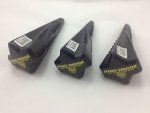That blue hydraulic gizmo was cool. I don't often see wedges of any sort used on trees that small, but it was cool. When I was in my early 20's, harvesting firewood, I sometimes used a chainsaw winch that was a capstan with a stretchy polyester kernmantle rope; I'd just grab the tree as high as I could conveniently put the line, then put a tension on it before dropping the tree. It was pretty quick, and I usually managed to land them where we wanted them.
Sure wish I knew what became of Dad's little chainsaw winch. We ran it off a little Homelite Super EZ saw, and it was handy. All the chainsaw winches I see now are cable types, and generally not cheap.
The really old wedges from the days of crosscut saws and nothing but old growth, are steel, very long, and very thin. Later wedges in the age of chainsaws and small timber got smaller with a bit more taper, and effort was made to make them of material that would not harm the chainsaw if the wedge was bumped. I think Dad may still have a magnesium wedge, and most common with guys dropping trees these days would be wedges in an assortment of brightly colored plastics.
They say more guys have been hurt in the woodlot that in professional falling. Maybe that's true. People don't respect the trees, get careless, then suddenly a leaning Alder "barberchairs" and comes back on a person. Small trees can kill you, too.
Back to the splitting wedges: This thread is a good reminder to me to take stock and see if I need any more. Haven't been cutting wood lately, and I lose track. Got my splitter back, so I should check out the engine on that and make sure it's OK. My saws still run, though I should face the fact that all but my more modern Husqvarna are sort of in the "disposable" category, once they quit. The Poulan I inherited from Mom was always disposable. The Homelites are just too old to find parts anymore. I must admit that the more modern Stihl and Husky saws are nicer to use, with all the CounterVibe handles and such.







